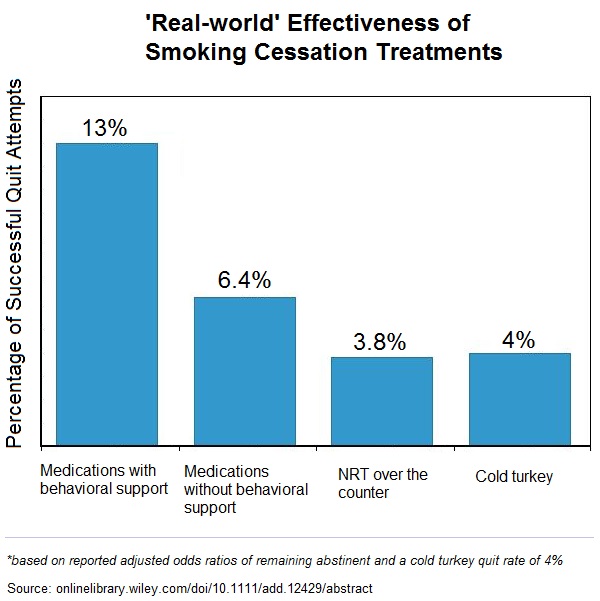
As ex-smokers, many vapers have actually tried nicotine replacement therapy (NRT) before. This encompasses things like gums and patches, which offer some nicotine in the hopes of minimizing withdrawal symptoms when you try to quit smoking. The problem is – as you may realize from first-hand experience – that NRT doesn’t really seem to work for the vast majority of smokers. A new piece of research published in the journal Addiction has looked at this issue, accounting for the potentially confounding variable of behavioral support to investigate whether NRT has any effect under more realistic conditions.
What They Did – Do Medicines, Patches and Gums Really Help You Quit?
The researchers used several months’ worth of data from the Smoking Toolkit Study – a regular monthly survey looking at smoking habits in England – to investigate whether or not there was a relationship between the use of different quitting methods and abstinence from smoking. The cross-sectional study used a sample of 10,335 adults, with anybody aged over 16 who’d smoked a cigarette and made a quit attempt in the previous year being eligible.
They didn’t include e-cigarettes in the research, instead looking at the impact of medication –including NRT, varenicline (Chantix/Champix) or bupropion (Wellbutrin) – with counseling, without behavioral support and NRT in over-the-counter settings, in comparison with “cold turkey” quitters. This is an issue because with many of the tests of both nicotine replacement therapy (NRT) and medicines such as Chantix involved counseling as standard, and this may not be representative of real-world usage. They classified participants according to the cessation method they used, and used their self-reported abstinence up to the time of the survey, mathematically adjusting for their level of tobacco dependence.
What They Found – Without Additional Support, NRT Doesn’t Seem to Work
The results show that out of the four considered options, the group who used both medication and behavioral support were most likely to quit. They were over three times more likely to have quit than the “cold turkey” group, but without counseling the quit rate for medication users was only 60 percent better than the cold turkey quitters. Given that only between three and five percent of cold turkey quitters succeed, this doesn’t correspond to a particularly impressive quit rate.
The group who used over the counter NRT without counseling had marginally lower quit rates than the cold turkey group, corresponding to no real difference between the groups from a statistical perspective. In other words, this implies that you might as well not use the NRT if you aren’t going to receive behavioral support as well.
This result isn’t necessarily representative of the actual effectiveness of NRT, but other evidence is also in agreement with this result. For example, a systematic review of the existing research on the topic found that the use of NRT only added between two to three percent onto cold turkey quit rates, translating to a maximum 8 percent success rate (after six months to a year). The “number needed to treat” for one user to successfully quit smoking was estimated to be between 33 and 50. This means that if 33 smokers tried NRT, only one would successfully quit, at best.

So, What’s the Best Way to Quit Smoking?
There are a couple of things to keep in mind about the new study before drawing any firm conclusions about it. It was a cross-sectional study, so it can’t provide any cause and effect evidence; it’s like a snapshot of the situation at the time of the survey. This is evident from the fact that the respondents reported the quit attempts they’d already tried. They weren’t assigned to specific groups and then followed to see their comparative success rates; which would produce weightier evidence. However, as noted above, the quit rates reported appear to be roughly in line with other research on the topic, so there’s no real reason to question its accuracy.
From the study, however, it’s clear that counseling is definitely a deciding factor in the success of quit attempts, because even the group using medication were considerably less likely to quit without it. This makes perfect sense, of course, because that’s how treatment for addictions generally works. Research has shown that around 17 percent of smokers receiving cognitive behavioral therapy were abstinent after six months, but this isn’t always a realistic option.
E-cigarettes are at least as effective as patches for quitting smoking, according to the results of a recent clinical trial, and have even been shown to work for smokers with no interest in quitting. This appeal to smokers with no interest in quitting is undoubtedly because e-cigs are a harm reduction approach. You can still enjoy the nicotine you want in a safer form.
Conclusion
This study may provide evidence of something many vapers already know, but it’s still interesting. The current state of smoking cessation is pretty dismal; nobody gets excited about gums and patches. Even though most smokers want to quit, they can’t do it. This is why vaping has so much potential; it’s something people actually get passionate about and the existing evidence is very positive. Crushing it through regulation would be a devastating and dangerous move.

